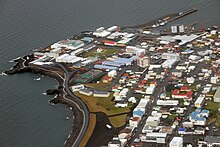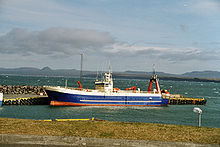Keflavík
Keflavík | |
|---|---|
 Aerial view | |
| Country | |
| Admin. division | Reykjanes |
| Population (2008) | |
| • Total | 14,000 |
Keflavík (IPA: [ˈkɛplɑˌviːk], Icelandic for "Driftwood Bay") is a town in the Reykjanes region in southwest Iceland.
In 1995 it merged with Njarðvík and Hafnir to form a municipality called Reykjanesbær with a population of 14,000 (June 2008).
History
Founded in the 16th century, Keflavík developed on account of its fishing and fish processing industry,[1] founded by Scottish entrepreneurs and engineers.[citation needed] Later its growth continued from flight operations at the Keflavík International Airport which was built by the US during the 1940s. The airport used to hold a significant NATO military base and was a vital pre-jet refueling stop for trans-Atlantic commercial air traffic. It now serves as Iceland's main international hub.


During World War II the military airfield served as a refueling and transit depot. During the Cold War, Naval Air Station Keflavik played an important role in monitoring marine and submarine traffic from the Norwegian and Greenland Seas into the Atlantic Ocean. Forces from the United States Air Force were added to provide radar monitoring, fighter intercept, in-flight refueling, and aerial/marine rescue. After the collapse of the Soviet Union, however, the base's role was cast into doubt. The base officially closed on 30 September 2006, when the United States withdrew the remaining 30 military personnel.
In Iceland, Keflavík was renowned as a rich source of musicians during the 1960s and 70s, and is therefore also known as bítlabærinn or "The Beatle Town".
In November 2008, in an official lunch with foreign diplomats, Icelandic President Ólafur Ragnar Grímsson shocked representatives of neighboring countries by saying that his country needed "new friends" and inviting Russia to make use of the strategically important air-base. The Russian ambassador responded that his country had no need of it.[2] Although the Icelandic president has no control over foreign policy, Ólafur Grímsson's remarks about lack of assistance in the financial crisis from countries other than Norway and the Faroe Islands and in particular about the UK's seizure of assets of Icelandic banks under an anti-terrorism law[3] implied that the offer was meant as a rebuke.[4]
Geography
The local geography is dominated by fields of basalt rubble, interspersed with a few hardy plants and mosses. On a clear day, one can see Snæfellsjökull across the bay, some 115 km away.
Fictional connections
The former NATO military base Naval Air Station Keflavik is used as a setting for an important story line in Tom Clancy's novel Red Storm Rising. Clancy accurately described the base, the geography, local flora, and the station equipment.
See also
- Keflavík International Airport
- Cold War
- Iceland Defense Force, headquartered in Keflavík until 2006
References
- ^ Cathy Harlow, Iceland, Landmark Visitors Guide, 3rd ed. 2004, ISBN 1-84306-134-1, p. 57.
- ^ "Russia invited to Iceland’s air-base", BarentsObserver.com, 12 November, 2008, accessed 6 October, 2009
- ^ "Iceland, Mired in Debt, Blames Britain for Woes" by Sarah Lyall, New York Times, 1 November, 2008, accessed 6 October, 2009.
- ^ "Inviterer Russland, by Alf Skeseth, Klassekampen, 12 November, 2008, accessed 6 October, 2009 (Norwegian).
